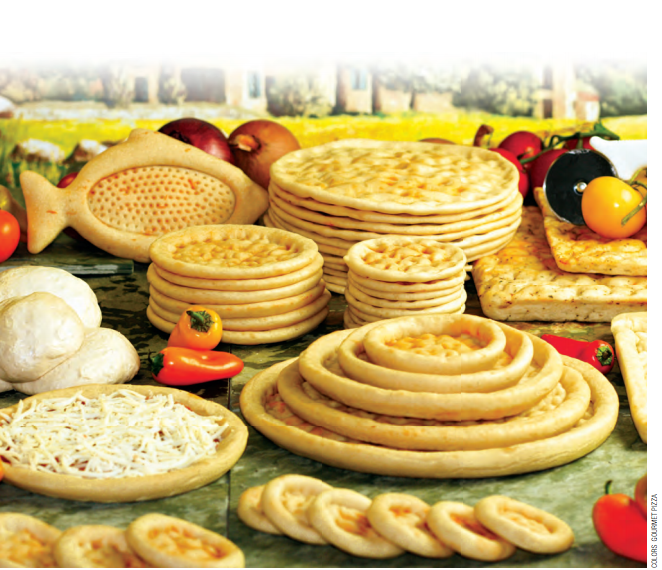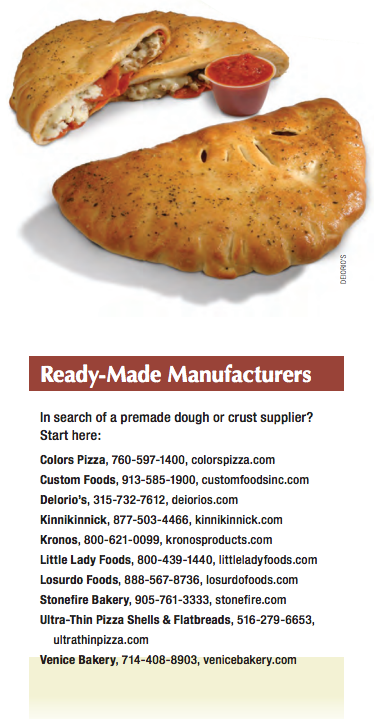
Dough—whether hand-tossed, rolled or sheeted into shape, whether thin-crust, deep-dish or pan style—is the foundation of a pizza and the pride on which many a pizzeria is built. And, while many owners rely on tried-and-true (in some cases, second or third-generation) recipes, with advances in technology and manufacturing, many premade dough and crust suppliers report that “frozen” or “premade” need not be the dirty words they once were in the pizza industry. New processes use fewer preservatives, or none at all; can confidentially duplicate family recipes to a tee; and often give pizzerias a chance to simplify operations, expand their brands, and explore new menu options.
Something Different
The most basic way to work with a dough supplier without taking the full premade plunge: Add a new crust or two to your menu. Specialty crusts can be difficult to perfect, and suppliers often spend years in research and development to come up with tasty combinations. For example, the Neapolitan style can be difficult to create for some pizzaiolos, but now this type of dough can be purchased from manufacturer Losurdo Foods, thanks to a partnership with Antimo Caputo, maker of “00” flour—ideal for those looking to easily add an artisan-style pie to the menu.
Buying premade might also be helpful when introducing healthy or whole-wheat options. “People want healthier options for themselves and their children,” says Bob Horth, vice president of business and development at DeIorio’s in Utica, New York. “But for that individual operator to mix up a batch of wheat dough—what a nightmare. You’ve got to experiment to make a product that works.”
Meanwhile, for celiacs and others on gluten-free diets, their diagnosis once meant giving up pizza and bread for good, since gluten (Latin for “glue”) is what makes a crust chewy and is present in traditional pizza. Having a gluten-free offering that caters to these special diets can mean a new loyal fan base and improved sales. “It’s very rewarding to get contacted weekly, whether through Facebook or direct feedback on our website, from people saying, ‘Thank you so much. My daughter hasn’t had pizza in 15 years and she wouldn’t even let us take a bite of this pizza,’” says Jimmy DeSisto, president and CEO of Venice Bakery in El Segundo, California.
A par-baked gluten-free crust is a natural choice for a pizzeria, since making such a dough on-site is a tough job. Flour in the air at a typical pizzeria easily could compromise such a dough’s safety for gluten-free diets, and many find that often-sticky and inconsistent gluten-free dough batter sometimes falls apart before it even makes it into the oven. Many in-house recipes may also yield a crumbly, bland crust. “The first time I experimented with this type of dough, I would put my teeth into a product and it tasted like I was biting into a stick of chalk—that’s how bad it was,” laughs DeSisto, whose gluten-free line required plenty of trial and error with different blends of rice flours, potato, tapioca, and other nontraditional ingredients.
Gluten-free crust manufacturers may also offer programs designed to help operations remain within the FDA’s allowable gluten range, working with operators to set up a gluten-free environment and test the gluten content of their final products.
Check with suppliers often to see what types of crusts they’re working on. Horth says his latest creation out of R&D is a bean-based dough that amps up the amount of protein and fiber with no reported negative effect on the flavor. “If you’ve got a situation where your customers want to eat healthier, do it in a fun food,” he says. “And let’s face it—pizza is a fun food!”
Outside the Pizzeria
A pizzeria operation isn’t always confined to four walls, but your brick oven probably doesn’t have wheels. Some situations when travel is a must—from catering and food truck operations to delivery and sidewalk sales—call for different equipment, and dough is no exception. Chef and owner Martial Bricnet from Colors Gourmet Pizza in Vista, California, advises pizza entrepreneurs to first consider what they want in the restaurant concept, and then ask themselves what will work, rather than struggling to conform their amazing dough recipe to work on a pizza truck or in a catering environment. “Decide what you want and work backwards,” he advises. “That wonderful pizza you had in Florence would be great if you had a little wine bar with 25 seats, but by the time it comes out of the kitchen, goes into a box, and get delivered, it’s going to be cold.” It’s also necessary to evaluate “pizza expectations,” he says. Pizza comes in many forms and remains satisfying—whether it’s a giant hot slice on game day or authentic Neopolitan. Different environments mean different expectations. Food trucks, farmers market stands and catering, for instance, dictate that pizza must be made quickly and be plentiful. With a diminished capacity to power a traditional pizza oven, a par-baked crust finished on a grill still excites customers without long prep and bake times and high energy needs. “We could do an oven and a heat lamp,” Bricnet says. “But imagine instead flatbread and a grill—now it’s a ‘wow’ thing! It’s very satisfying and fast, and a parbake in that environment works well.”
Horth, too, is familiar with the negative effects of pizza that has spent too much time under the heat lamp. To combat the problem, DeIorio’s developed high-moisture par-baked crusts that he says perform well for food vendors or outlets in sports venues. Premade dough can be made the old-fashioned way—in which it gets to relax, ferment and retain moisture—and when the operator bakes it the second time, it turns into “a moist and flavorful product,” says Horth.
Par-baked crusts are available in a wide variety of crust styles and even shapes, from ovals and rectangles to star-shaped pizza. Some even come complete with high-quality toppings. One manufacturer sells a 18”-by-26” par-baked “party pizza” that typically weighs in at five pounds when topped. If it wasn’t par-baked, this type of order could really tie up your production!
Additional Benefits
Premade pizza dough and crusts satisfy a bevy of needs. Here are some additional benefits of premade dough:
Consistency: Typically, the main reason a pizzeria will find a dough supplier is to ensure that the pizza crust remains the same high-quality product at every location, every day. “We all know that even if we give 10 chefs the exact same recipe and exact same raw materials, we’re going to have differentiation in product, depending on who made it,” says DeSisto. Other variations, such as different types of mixers at different locations, can also throw off consistency. Some suppliers offer recipe duplication services, so operators can order big batches of their own dough. Depending on the supplier, even small pizzerias can take advantage of this service. “You can customize products without huge minimum requirements,” says Horth. “We’re not going to demand truckloads of production from the get-go.” Meanwhile, Horth notes, a nondisclosure contract will ensure that the manufacturer doesn’t resell anyone’s family-secret dough recipe.
New menu items: When a talented chef is in the kitchen with a ball of dough or a par-baked crust and a few other ingredients, the menu (gluten-free or otherwise) is really only limited by the chef’s imagination, says DeSisto. He rattles off a list of potential menu items that can be made with premade dough: breadsticks, cinnamon rolls, Italian doughnuts, panini sandwiches, calzones and stromboli.
Cost: Dough suppliers can help cut restaurant costs. “If you’re an independent operator and you’re using 50-pound bags of flour, you’ve seen prices skyrocket in a very short amount of time,” says Horth. Pairing up with a supplier means the volume discounts are passed on to you. Also keep in mind other costs, such as labor, on your end, he advises: “All those things do add up, so premade dough helps close that gap.”
Last-resort abilities: Sometimes, homemade dough or pizza machinery fails. A few balls of dough kept on hand, maybe typically used to make extras such as dessert pizzas, can save the day. “It happens,” acknowledges Bricnet. “There’s no way that we can be perfect all the time. That’s Murphy’s law: If it can happen, it will, and it does over and over again.”














